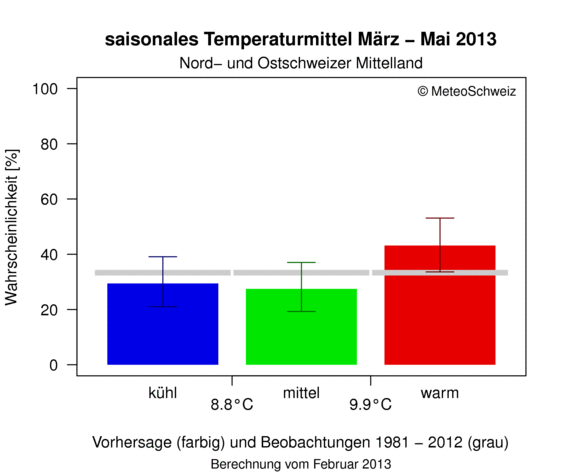Man hört es nicht gern, aber der meteorologische Winter nähert sich rasant seinem Ende. Temperaturmäßig verliefen die vergangenen drei Monate mehr oder weniger durchschnittlich, bei tendenziell überdurchschnittlich viel Schnee und extrem wenig Sonnenstunden. Die astronomischen Jahreszeiten orientieren sich am Sonnenstand (Winter: Wintersonnenwende – Frühjahrsäquinoktium). Die meteorologischen Jahreszeiten machen es sich einfacher und beginnen am jeweils Ersten des Monats, in dem auch die astronomischen Jahreszeiten beginnen. Meteorologisch gesehen sind also Dezember, Januar und Februar die Wintermonate, März, April und Mai Frühlingsmonate und so weiter. Das macht es wesentlich einfacher, saisonale Vergleiche durchzuführen, da man die Mittel ganzer Monate verwenden kann und nicht umständlich ausrechnen muss, wann nun zum Beispiel die Wintersonnenwende genau war (20. oder 21. Dezember), um dann die entsprechenden Werte gesondert zu ermitteln. Im meteorologischen Winter 2012/13 kam Österreich nur auf 37% der im langjährigen Mittel (1981-2010) üblichen Sonnenstunden. Schneerekorde gab es vor allem im Flachland, etwa in Wien und Bregenz, wobei auch die höheren Lagen gut mit Schnee versorgt wurden. Abgesehen von Extremereignissen wie dem Tauwetter zum Jahreswechsel lagen die Temperaturen im durchschnittlichen Bereich, Perioden mit strengem Frost blieben aus.

Saisonprognosen
Der Winter mag, zumindest nach einer der möglichen Definitionen, nun vorbei sein, skifahrerisch ist der bevorstehende Frühling aber natürlich nicht weniger interessant. Nun gibt es von diversen Diensten immer wieder Versuche, Saisonprognosen zu erstellen. Von den Anbietern werden die Ergebnisse meist mit dem Hinweis versehen, dass man sich keinesfalls sicher ist und bitte niemand die Urlaubsplanung danach ausrichten möge (http://www.meteoschweiz.admin.ch/web/de/klima/klima_morgen/klimaausblick/klimaausblick_winter/saisonale_vorhersage_wi.html). Manche Medien hingegen freuen sich, wenn sie einen „Glutsommer“ oder ähnliches ankündigen können, weil jemand berechnet hat, dass der nächste Sommer mit einer Wahrscheinlichkeit von 55% wärmer wird als der Durchschnitt der letzten 30 Jahre. (Wenn man nicht rechnet, sondern rät, liegt diese Wahrscheinlichkeit übrigens bei 50%.)

In Langzeitprognosen werden Trends und Tendenzen für größere Gebiete ermittelt. Es ist nicht möglich, schon im September zu bestimmen, ob es an Heilig Abend in München-Schwabing schneit. Man kann höchstens sagen, ob es in den kommenden Monaten in Mitteleuropa eher kälter oder feuchter wird, als im Mittel üblich. Dazu werden meist gekoppelte Ozean-Atmosphären Modelle herangezogen, die Größen wie Meeresoberflächentemperatur, Ausdehnung des Meereises, Schneebedeckung und Bodenfeuchte verwenden, um basierend auf statistischen Erfahrungswerten gewisse Aussagen zu treffen. In Gegenden, deren Klima stark von Phänomenen wie ENSO (el Niño/ la Niña) beeinflusst ist, funktioniert das besser als hierzulande, wo sich die Witterungsbedingungen schneller verändern und das „Hintergrundrauschen“ (=rasch wechselnde Wetterlagen) andere Signale überlagert. Andere Ansätze beruhen auf Analogie- („letzten Sommer war die Temperatur- und Druckverteilung so wie jetzt, also wird dieser Sommer ähnlich verlaufen“) oder Korrelationsprinzipien („weil die Druckverteilung auf der Nordhalbkugel zu Zeitpunkt X so ist, wird sie zu Zeitpunkt Y entsprechend anders sein“.) Je besser komplexe Zusammenhänge verstanden werden und je leistungsfähiger vor allem die dynamischen Ozean-Modelle werden, desto besser werden auch saisonale Prognosen. Abschließend kurz die weniger langfristigen Aussichten: Das Tief im Süden verliert an Einfluss und zum Wochenende dürfte sich mehr oder weniger überall die Sonne durchsetzen, wobei sich teilweise in tieferen Lagen zäher Hochnebel hält. Top Tourenwetter pünktlich zum Frühjahrsbeginn!







